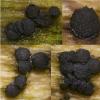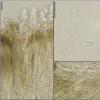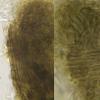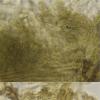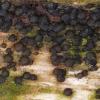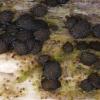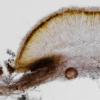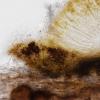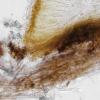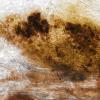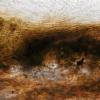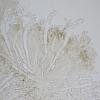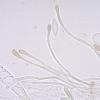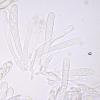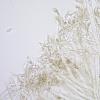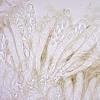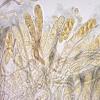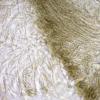
20-12-2025 23:08
Patrice TANCHAUDBonsoir, récolte sur sol sablonneux dans l'arri�

20-12-2025 15:47
Mirek GrycHi.These grew on pine wood that was heavily covere

18-12-2025 21:17
Pol DebaenstThe identification took me to Byssonectria deformi

15-12-2025 07:09
 Danny Newman
Danny Newman
indet. Rutstroemiaceae sp. on unk. fallen leavesMc

19-12-2025 10:10
Patrice TANCHAUDBonjour, récolte réalisée en milieu dunaire, a

18-12-2025 17:23
 Bruno Coué
Bruno Coué
Bonjour,je serais heureux d'avoir votre avis sur c

18-12-2025 18:07
Margot en Geert VullingsThese plumes were found on rotten wood.They strong

17-12-2025 18:35
 Michel Hairaud
Michel Hairaud
Bonjour à tous/Hi to everyone I am passing along
Discomycete
Gernot Friebes,
22-01-2011 21:06
another species which I cannot determine without your help. It has very stricking characters but I have never seen something like this before.
It grew on a decorticated stem of a decidious tree lying on the ground. The apothecia were black, sometimes with a crenulate margin, the surface looked a bit rough, they very quite soft. Asci were remarkably long, spores biseriate, IKI-, croziers+, up to *95 x 9 µm, extremely shrinking in KOH. Spores were smooth, non-septate, hyaline, ovate to irregularly elliptical, usually tapering at one end, quite variable in size and shape, measuring 6-9(10) x 3-4 µm. Paraphyses were covered by a thick layer of green brown exudate which turns darker in KOH.
Best wishes,
Gernot
Hans-Otto Baral,
22-01-2011 21:34

Re:Discomycete
Hi Gernot
this could be Durella commutata, but I wonder about its rough margin wich is smooth in that species. There are also refractive vacuoles in the tips of living paraphyses which i cannot see in yours. Could you look at the ectal excipulum, it should be a brown oblita-porrecta, well seen in surface view, and very thin in section.
Zotto
this could be Durella commutata, but I wonder about its rough margin wich is smooth in that species. There are also refractive vacuoles in the tips of living paraphyses which i cannot see in yours. Could you look at the ectal excipulum, it should be a brown oblita-porrecta, well seen in surface view, and very thin in section.
Zotto
Gernot Friebes,
22-01-2011 21:51
Re:Discomycete
Hi Zotto,
good tip, thank you! I didn't think of a Durella because of the crenulate margin and because I didn't see the excipulum which is normally well visible in a squash mount. Tomorrow I will check paraphyses and excipulum more precisely.
Best wishes,
Gernot
good tip, thank you! I didn't think of a Durella because of the crenulate margin and because I didn't see the excipulum which is normally well visible in a squash mount. Tomorrow I will check paraphyses and excipulum more precisely.
Best wishes,
Gernot
Gernot Friebes,
23-01-2011 19:35
Re:Discomycete
Hi,
I had another look at this fungus today and I really think that it is a Durella. The spores become 1-septate when old and I found some asci which were up to 100 µm long. The excipulum does not look like a typical Durella-excipulum as I know it but still I think it fits for this genus, doesn't it?
Best wishes,
Gernot
I had another look at this fungus today and I really think that it is a Durella. The spores become 1-septate when old and I found some asci which were up to 100 µm long. The excipulum does not look like a typical Durella-excipulum as I know it but still I think it fits for this genus, doesn't it?
Best wishes,
Gernot
Hans-Otto Baral,
23-01-2011 21:54

Re:Discomycete
Hi Gernot
it could be but I am still in doubt. The macro resembles more D. atrocyanea with 3-septate spores, which might deserve a separate genus. What you could do is testing with KOH: in Durella nothing happens to the dark brown pigment, but with atrocyaena (I use Xylogramma for that) the olivaceous pigment dissolves similar as in Claussenomyces.
Also: did you see living paraphyses? If they are devoid of VBs then it hardly can be D. commutata.
Zotto
it could be but I am still in doubt. The macro resembles more D. atrocyanea with 3-septate spores, which might deserve a separate genus. What you could do is testing with KOH: in Durella nothing happens to the dark brown pigment, but with atrocyaena (I use Xylogramma for that) the olivaceous pigment dissolves similar as in Claussenomyces.
Also: did you see living paraphyses? If they are devoid of VBs then it hardly can be D. commutata.
Zotto
Gernot Friebes,
23-01-2011 22:08
Re:Discomycete
Hi Zotto,
I wrote what I have seen when adding KOH: "Paraphyses were covered by a thick layer of green brown exudate which turns darker in KOH." The exudate is still there but looses a bit of the green colour and turns darker.
Sorry, I forgot to write about the paraphyses. I didn't see any content, neither in living nor in dead material. Altogether, It really seems to be something different than D. commutata.
Best wishes,
Gernot
I wrote what I have seen when adding KOH: "Paraphyses were covered by a thick layer of green brown exudate which turns darker in KOH." The exudate is still there but looses a bit of the green colour and turns darker.
Sorry, I forgot to write about the paraphyses. I didn't see any content, neither in living nor in dead material. Altogether, It really seems to be something different than D. commutata.
Best wishes,
Gernot
Hans-Otto Baral,
23-01-2011 22:13

Re:Discomycete
Yes, it is strange, this group around Durella. Lots of confusion, and I still have no clear idea what the type, Durella compressa, really is (surely not yours).
Zotto
Zotto
Gernot Friebes,
30-01-2018 14:10
Re : Discomycete
A. Gallé has now found a collection on wood of Castanea that seems identical with my material from 2011. I attach a few photos by myself first and in the next post you can see photos of the same (new) collection by Annemarie. The spore size of the two collections is similar.
Still not sure what it could be!
Best wishes,
Gernot
Still not sure what it could be!
Best wishes,
Gernot

